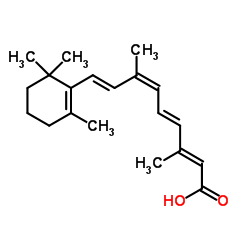Alitretinoin

Alitretinoin structure
|
Common Name | Alitretinoin | ||
|---|---|---|---|---|
| CAS Number | 5300-03-8 | Molecular Weight | 300.435 | |
| Density | 1.0±0.1 g/cm3 | Boiling Point | 462.8±14.0 °C at 760 mmHg | |
| Molecular Formula | C20H28O2 | Melting Point | 189-191ºC | |
| MSDS | Chinese USA | Flash Point | 350.6±11.0 °C | |
| Symbol |


GHS07, GHS08 |
Signal Word | Danger | |
Use of Alitretinoin9-cis-Retinoic acid (ALRT1057), a vitamin A derivative, is a potent RAR/RXR agonist. 9-cis-Retinoic acid induces apoptosis, regulates cell cycle and has anticancer, anti-inflammatory and neuroprotection activities[1][2][3][4][5]. |
| Name | 9-cis-retinoic acid |
|---|---|
| Synonym | More Synonyms |
| Description | 9-cis-Retinoic acid (ALRT1057), a vitamin A derivative, is a potent RAR/RXR agonist. 9-cis-Retinoic acid induces apoptosis, regulates cell cycle and has anticancer, anti-inflammatory and neuroprotection activities[1][2][3][4][5]. |
|---|---|
| Related Catalog | |
| In Vitro | 9-cis-Retinoic acid (1-10 μM; 0-5 days; CA 9-22 and NA cells) treatment significantly decreases proliferation in a dose-dependent manner in CA 9-22 and NA cells[1]. 9-cis-Retinoic acid (1 μM; 24 hours) treatment significantly increases PPARγ functional activity by >200% in CA 9-22 and NA aerodigestive cells[1]. 9-cis-Retinoic acid treatment results in the formation of a nuclear PPARγ-RXRα heterodimer supershift complex in CA 9-22 cells[1]. 9-cis-Retinoic acid inhibits proliferation and induces apoptosis in cutaneous T-cell lymphoma (CTCL) in a dose-dependent and time-dependent manner. 9-cis-Retinoic acid also induces G0/G1 cell cycle arrest by downregulation of cyclin D1. 9-cis-Retinoic acid significantly decreases phosphorylation of JAK1, STAT3, and STAT5 and downregulated Bcl-xL and cyclin D1[2]. Cell Proliferation Assay[1] Cell Line: CA 9-22 and NA cells Concentration: 1 μM, 10 μM Incubation Time: 0 day, 1 day, 3 days, 5 days Result: Significantly decreased proliferation. |
| In Vivo | 9-cis-Retinoic acid (1 mg/kg; intravenous injection; daily; for 10 days; male C57BL/6J mice) treatment significantly decreases the serum ALT and AST level, alleviates hepatic necrosis of the bile duct ligation (BDL)-mice[3]. Animal Model: Male C57BL/6J mice (6-8 weeks; 19-22 g) treatment with bile duct ligated[3] Dosage: 1 mg/kg Administration: Intravenous injection; daily; for 10 days Result: Significantly decreased the serum ALT and AST level, alleviated hepatic necrosis. |
| References |
| Density | 1.0±0.1 g/cm3 |
|---|---|
| Boiling Point | 462.8±14.0 °C at 760 mmHg |
| Melting Point | 189-191ºC |
| Molecular Formula | C20H28O2 |
| Molecular Weight | 300.435 |
| Flash Point | 350.6±11.0 °C |
| Exact Mass | 300.208923 |
| PSA | 37.30000 |
| LogP | 6.83 |
| Vapour Pressure | 0.0±2.5 mmHg at 25°C |
| Index of Refraction | 1.556 |
| InChIKey | SHGAZHPCJJPHSC-ZVCIMWCZSA-N |
| SMILES | CC(C=CC1=C(C)CCCC1(C)C)=CC=CC(C)=CC(=O)O |
| Storage condition | −20°C |
| Stability | Store Dry in Freezer at -20°C for up to 1 year; in Solution at -20°C for up to 3 Months. |
| Symbol |


GHS07, GHS08 |
|---|---|
| Signal Word | Danger |
| Hazard Statements | H315-H319-H335-H360 |
| Precautionary Statements | P201-P261-P305 + P351 + P338-P308 + P313 |
| Personal Protective Equipment | Eyeshields;full-face particle respirator type N100 (US);Gloves;respirator cartridge type N100 (US);type P1 (EN143) respirator filter;type P3 (EN 143) respirator cartridges |
| Hazard Codes | T: Toxic; |
| Risk Phrases | R36/37/38;R61 |
| Safety Phrases | S26-S36/37/39-S45-S53 |
| RIDADR | NONH for all modes of transport |
| WGK Germany | 3 |
| HS Code | 2916209090 |
| HS Code | 2916209090 |
|---|---|
| Summary | 2916209090 other cyclanic, cyclenic or cyclotherpenic monocarboxylic acids, their anhydrides, halides, peroxides, peroxyacids and their derivatives VAT:17.0% Tax rebate rate:9.0% Supervision conditions:AB(certificate of inspection for goods inward,certificate of inspection for goods outward) MFN tariff:6.5% General tariff:30.0% |
|
Modulators of hepatic lipoprotein metabolism identified in a search for small-molecule inducers of tribbles pseudokinase 1 expression.
PLoS ONE 10 , e0120295, (2015) Recent genome wide association studies have linked tribbles pseudokinase 1 (TRIB1) to the risk of coronary artery disease (CAD). Based on the observations that increased expression of TRIB1 reduces se... |
|
|
Cheminformatics analysis of assertions mined from literature that describe drug-induced liver injury in different species.
Chem. Res. Toxicol. 23 , 171-83, (2010) Drug-induced liver injury is one of the main causes of drug attrition. The ability to predict the liver effects of drug candidates from their chemical structures is critical to help guide experimental... |
|
|
Developmental regulation and induction of cytochrome P450 2W1, an enzyme expressed in colon tumors.
PLoS ONE 10(4) , e0122820, (2015) Cytochrome P450 2W1 (CYP2W1) is expressed predominantly in colorectal and also in hepatic tumors, whereas the levels are insignificant in the corresponding normal human adult tissues. CYP2W1 has been ... |
| 9-cis-Tretinoin,Alitretinoin |
| (9cis)-Retinoic acid |
| Alitretinoin |
| (2E,4E,6Z,8E)-3,7-dimethyl-9-(2,6,6-trimethylcyclohex-1-en-1-yl)nona-2,4,6,8-tetraenoic acid |
| 9-cis-retinoic acid |
| MFCD00270072 |
| 9Z-retinoic acid |
| 9-cis-Tretinoin |
| 9-cis Retinoic Acid |
| Panretin Gel |
| (2E,4E,6Z,8E)-3,7-dimethyl-9-(2,6,6-trimethylcyclohexen-1-yl)nona-2,4,6,8-tetraenoic acid |
| Retinoic acid, (9cis)- |
| 9(Z)-Retinoic acid |

